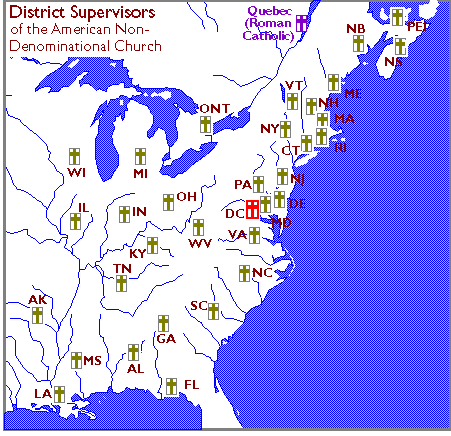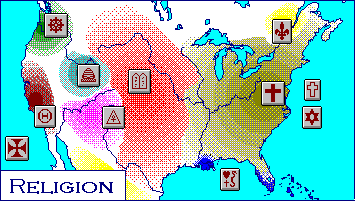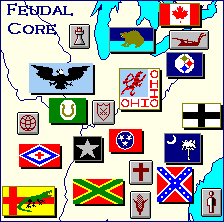
The American Non-Denominational Church

Although one of the founding principles of the United States had been a strict separation of church and state, nothing lasts forever. As the world slid into the abyss, the US government experimented with a bit of state-sponsored spirituality to soothe the tortured soul of the nation. In its early forms, this new religion tried to reduce all the faiths of America to their lowest common denominators and encourage an inoffensive and non-denominational unity with silent moments of contemplation.
Eventually it became obvious that silence was not enough to get God's attention. Maybe it would be better to address Him by name:
"One nation, under God. Got it?"
It took many generations to solidify the new symbiosis between church and state as all the factions tried to wrestle the law in their direction. Hundreds of Supreme Court decisions were needed to codify the new orthodoxy. For example, when does life begin, and when does it end? Under what circumstances is divorce permissible? Can evolution and Genesis be reconciled? Does an eye for an eye and a tooth for a tooth constitute cruel and unusual punishment? After a few centuries of this, the Chief Justice had become the acknowledged arbiter of the faith.
Even though the United States had shrunk to a small coastal enclave, the American Non-Denominational Church retained its prestige. A nod from the church, for example, could legitimize a usurper on a shaky throne and earn a favor in return. It could negotiate treaties and interpret tradition, and people would obey because it spoke with the voice of God. Although it often found itself at odds with the ruling class when the charitable impulses of the churchmen clashed with the ambitions of the warlords, the church thrived (aside from an occassional massacre of martyrs) because it filled a vital need for skilled bureacrats.

In the age of hand-to-hand combat, training in the martial arts was a full-time job. After all, it takes a lot more skill to fight a saber duel than it does to rake a field with machine gun fire, so very few members of the warrior class had the time to get the education necessary to tally taxes, build bridges, deliver the mail, calculate a calendar or record the great deeds of historic figures. The obvious answer would be for each nation to maintain its own schools for the training of bureaucrats, but this cost a lot of money, so it was cheaper to just hire the churchmen as bureaucrats instead.
The danger here was that an ambitious cleric might scheme to replace his warlord's dynasty with one founded by himself, but this danger faded once the church agreed to impose a vow of celebacy on its members.

Theologically, the American Non-Denominational Church is generic New-Testament Christianity, with enough pomp and ritual to awe even the most cynical doubter. By maintaining hospitals, orphanages and schools, they operate as a Department of Social Services in a world that has dropped such frivolous expenditures. The major holy days of the Non-Denoms are Christmas (25 December), Thanksgiving (the last Thursday in November), Easter (the last Sunday in March), New Year's Day (1 January), Independence Day (4 July) and Tithing Day (15 April).
Politically, the Non-Denominational Church is autonomous. It runs its own affairs without the interference of the secular authorities, and the churchmen are disciplined by the laws of the Church rather than the laws of the state. Similarly, the state is relatively free from day to day interference by the church, and common criminals are judged and punished by the secular laws of the warlords. Geographically, the Church is conservative, being centrally administered by the Supreme Court in Washington, and locally adminstered by District Supervisors headquartered in the old state capitals. The Church is somewhat republican in its structure. Even though doctine is set by majority vote within the Supreme Court, dissenting justices are allowed to issue conflicting opinions keeping the debate alive. Vacancies in the Supreme Court Justices are filled by a vote among the Supervisors, and vacancies among the Supervisors are filled by a vote of the Supreme Court.
Notice that almost half the Districts are located in the Northeast. This historical quirk has given this region a disproportionate influence over church affairs.



Last Updated January 2003
Copyright © 1999-2003 Matthew White